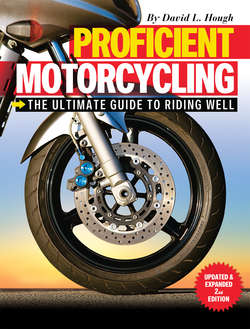Читать книгу Proficient Motorcycling - David L. Hough - Страница 14
На сайте Литреса книга снята с продажи.
How Far Are You Hanging It Out?
ОглавлениеI don’t know how you learned to ride a motorcycle, but I taught myself. Back in the mid-sixties, my old buddy Ricochet Red had started commuting to work on a Honda 90 and quickly graduated to a big Honda 160. I tried Red’s 160 and immediately saw the potential for beating automobile traffic on and off the Seattle ferry. Within a week, I found a clean used Suzuki 150 twin for $300.
Of course there weren’t many training courses around in the sixties. Red coached me through a half hour of practice on his Honda behind the grade school one Saturday afternoon. Monday morning, I climbed on the Suzuki and zipped off into rush-hour traffic. It rained that very first day, and I remember squish-squishing around the office as I mulled over the implications of motorcycles and weather. That was the start of my motorcycling education.
Of course, there were people around the office who clucked their tongues at my foolishness. Everyone knew motorcycles were dangerous, and riding a motorcycle to work in heavy traffic had to be high-risk foolishness. There were snide remarks and stupid jokes. One co-worker even approached me, gripped my shoulder with fatherly sincerity, and offered the opinion, “I sure wouldn’t want my son to ride one of those things.” A few days later, when I arrived at the ophthalmologist carrying my helmet, the doctor gave me a twenty-minute lecture on the hazards of riding motorcycles and a five-minute eye exam.
I wouldn’t admit it to anyone at the time, but that barrage of antimotorcycle flak caused me to have some serious doubts about motorcycling. I had a wife, two young children, and a mortgage. And I sure didn’t want to spend the rest of my life in a wheelchair. I recall one day toward the end of the second week when I nearly gave it up. After work, I’d strapped my lunchbox to the back of the bike, put on my helmet, and started the engine, but I was a little reluctant to get rolling. Factory traffic is notoriously aggressive at shift change. I sat on the bike for a long time in the corner of the parking lot, watching cars wedge into the stream and trying to control my rising panic. Eventually, I forced myself to get on the bike and ride home. And I’m still riding. Over the next forty-plus years, I gradually learned some important lessons about motorcycling. The first lesson was that my co-workers and my ophthalmologist didn’t know diddly about motorcycling or motorcycle safety.
Looking back, I have to agree that the basic concern of my colleagues was probably realistic. A lot of people have gotten messed up in motorcycle crashes, and new riders are particularly vulnerable. But what neither my associates nor I understood at the time is that the risks of motorcycling vary significantly from individual to individual. One rider may have a serious crash soon after taking up motorcycling. Another rider may survive years and years without having a single incident.
Is it just a matter of chance that one rider suffers a crash while another rider avoids crashing? Is swinging a leg over a motorcycle just a two-wheeled form of Russian roulette? I don’t think so. During the years I’ve been riding, writing, and teaching, quite a pile of statistics have been collected. We don’t have nearly as much specific data available as we’d like, but we have a much better idea of the risks now than anyone had back in the sixties.
Is motorcycling a two-wheeled version of Russian Roulette, or can we really manage the risks?
Let’s take a short, fast ride through risk territory. We’ll give you a little quiz at the end to help you see how you’re doing.
